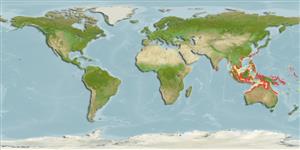(كوسه ها و سپرماهيان) (sharks and rays) >
Myliobatiformes (Stingrays) >
Dasyatidae (Stingrays) > Urogymninae
Etymology: Himantura: Greek, iman, imantos = thong, strap + Greek, oura = tail (Ref. 45335).
More on author: Bleeker.
Environment: milieu / climate zone / depth range / distribution range
بوم شناسي
دريايي نزديك كف زي. Tropical; 30°N - 24°S
Indo-West Pacific: Bay of Bengal to New Guinea, north to the Ryukyu Islands, south to northern Australia. Not occurring in the western Indian Ocean.
Length at first maturity / Size / Weight / سن
Maturity: Lm 87.5, range 85 - 90 cm
Max length : 410 cm TL جنس نر / بدون خواص جنسي; (Ref. 9840)
Demersal on soft substrate inshore (Ref.58048). Ovoviviparous (Ref. 50449). Size at birth about 20 cm WD and 92 cm TL (Ref. 90102). Caught occasionally in the demersal tangle net, bottom trawl and longline fisheries. Utilized for its meat, skin (high value) and cartilage (Ref.58048).
Life cycle and mating behavior
بلوغ | تولید مثل | تخم ریزی | تخم ها | Fecundity | توزاد ( لارو)
Exhibit ovoviparity (aplacental viviparity), with embryos feeding initially on yolk, then receiving additional nourishment from the mother by indirect absorption of uterine fluid enriched with mucus, fat or protein through specialised structures (Ref. 50449). Distinct pairing with embrace (Ref. 205). Distinct pairing with embrace (Ref. 205).
Last, P.R. and J.D. Stevens, 1994. Sharks and rays of Australia. CSIRO, Australia. 513 p. (Ref. 6871)
وضعيت در فهرست قرمز IUCN (Ref. 130435: Version 2024-1)
استفاده انسانی
ماهي گيري – شيلات: ارزش تحاري اندك
ابزارها
گزارش های ويژه
بارگيری XML
منابع اينترنتي
Estimates based on models
Preferred temperature (Ref.
123201): 25 - 29, mean 28.3 °C (based on 810 cells).
Phylogenetic diversity index (Ref.
82804): PD
50 = 0.5000 [Uniqueness, from 0.5 = low to 2.0 = high].
Bayesian length-weight: a=0.01023 (0.00486 - 0.02155), b=3.06 (2.87 - 3.25), in cm total length, based on LWR estimates for this (Sub)family-body shape (Ref.
93245).
Trophic level (Ref.
69278): 3.6 ±0.5 se; based on size and trophs of closest relatives
Fishing Vulnerability (Ref.
59153): Very high vulnerability (90 of 100).
